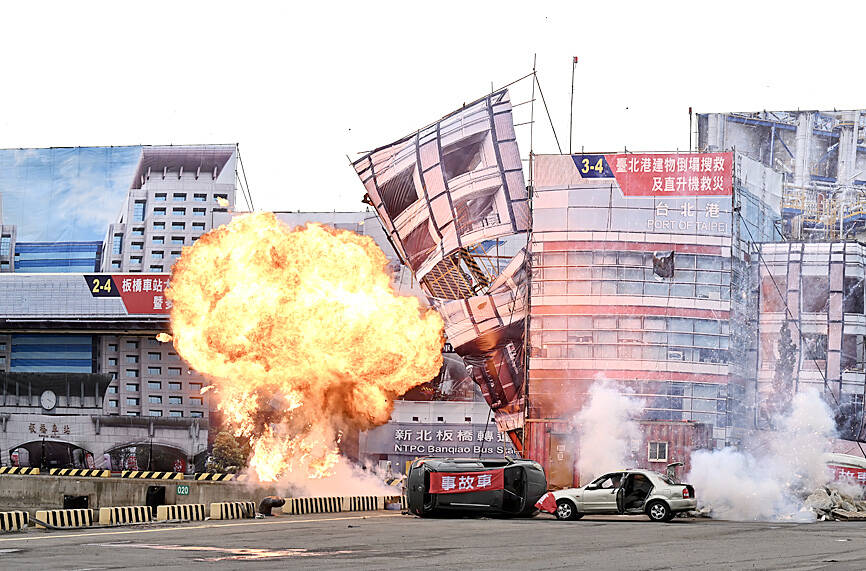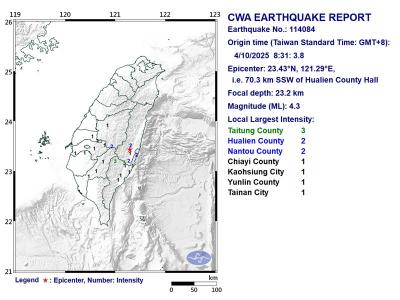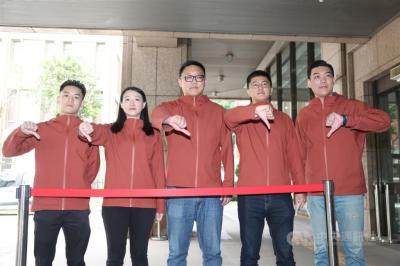About 900 civilians would practice using military field hospital equipment without the assistance of military personnel during civil defense drills in Tainan on Thursday, a source said yesterday.
Although the drills are to be staged in Tainan, fire departments in Kaohsiung and Chiayi County and alternative service conscripts would also participate, the official said on condition of anonymity.
On Tuesday last week, Presidential Office spokesperson Karen Kuo (郭雅慧) said that the small-scale exercise would simulate a severe “compound disaster” scenario involving earthquakes, tsunamis and critical infrastructure disruptions.

Photo: Lo Pei-de, Taipei Times
The drills would test central and local governments’ emergency response capabilities, such as large-scale evacuations, sheltering and establishing emergency medical facilities, she said.
They would also feature civilian participation to test public-private sector cooperation in the event of a major disaster to enhance whole-of-society defense resilience, she said.
Although military personnel would not take part, the Ministry of National Defense’s Medical Affairs Bureau would lend its newly purchased Forward Resuscitative and Surgical Detachment (FRSD) medical sets and inflatable field hospital tents for use in the exercise, the source said.
FRSD is a set of medical supplies and equipment designed to enable the rapid deployment of an urgent, initial surgical care unit, providing critical treatment capabilities close to the front line, the source said.
The weatherproofed inflatable field hospital tents are quick and easy to set up and light for transportation and are used to treat patients in the aftermath of natural disasters and in war zones, the source added.
A senior Ministry of the Interior official said on condition of anonymity yesterday that unlike previous rounds of civil defense or Wanan air raid drills, Thursday’s exercise would be “unscripted and more realistic.”
The official added that following the Tainan exercise, the government would proceed with Urban Resilience Exercises from next month until July, which combine the Wanan air raid and Minan disaster response drills.
The series of exercises would culminate in the live-fire portion of the armed forces’ annual Han Kuang drills in July, the official added.
Thursday’s exercise is to take place from 10am to 2pm at Tainan Municipal Nan-ning High School, the Anping Port Visitors’ Center and the square across from the Tainan Yuping Post Office, the Presidential Office said.
President William Lai (賴清德) and Vice President Hsiao Bi-khim (蕭美琴) are to travel to Tainan to preside over the exercises, the source said.
Representatives from foreign missions in Taiwan have also been invited, the source added.

Taiwan is stepping up plans to create self-sufficient supply chains for combat drones and increase foreign orders from the US to counter China’s numerical superiority, a defense official said on Saturday. Commenting on condition of anonymity, the official said the nation’s armed forces are in agreement with US Admiral Samuel Paparo’s assessment that Taiwan’s military must be prepared to turn the nation’s waters into a “hellscape” for the Chinese People’s Liberation Army (PLA). Paparo, the commander of the US Indo-Pacific Command, reiterated the concept during a Congressional hearing in Washington on Wednesday. He first coined the term in a security conference last

A magnitude 4.3 earthquake struck eastern Taiwan's Hualien County at 8:31am today, according to the Central Weather Administration (CWA). The epicenter of the temblor was located in Hualien County, about 70.3 kilometers south southwest of Hualien County Hall, at a depth of 23.2km, according to the administration. There were no immediate reports of damage resulting from the quake. The earthquake's intensity, which gauges the actual effect of a temblor, was highest in Taitung County, where it measured 3 on Taiwan's 7-tier intensity scale. The quake also measured an intensity of 2 in Hualien and Nantou counties, the CWA said.

The Overseas Community Affairs Council (OCAC) yesterday announced a fundraising campaign to support survivors of the magnitude 7.7 earthquake that struck Myanmar on March 28, with two prayer events scheduled in Taipei and Taichung later this week. “While initial rescue operations have concluded [in Myanmar], many survivors are now facing increasingly difficult living conditions,” OCAC Minister Hsu Chia-ching (徐佳青) told a news conference in Taipei. The fundraising campaign, which runs through May 31, is focused on supporting the reconstruction of damaged overseas compatriot schools, assisting students from Myanmar in Taiwan, and providing essential items, such as drinking water, food and medical supplies,

Prosecutors today declined to say who was questioned regarding alleged forgery on petitions to recall Democratic Progressive Party (DPP) legislators, after Chinese-language media earlier reported that members of the Chinese Nationalist Party (KMT) Youth League were brought in for questioning. The Ministry of Justice Investigation Bureau confirmed that two people had been questioned, but did not disclose any further information about the ongoing investigation. KMT Youth League members Lee Hsiao-liang (李孝亮) and Liu Szu-yin (劉思吟) — who are leading the effort to recall DPP caucus chief executive Rosalia Wu (吳思瑤) and Legislator Wu Pei-yi (吳沛憶) — both posted on Facebook saying: “I